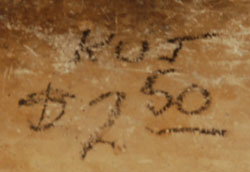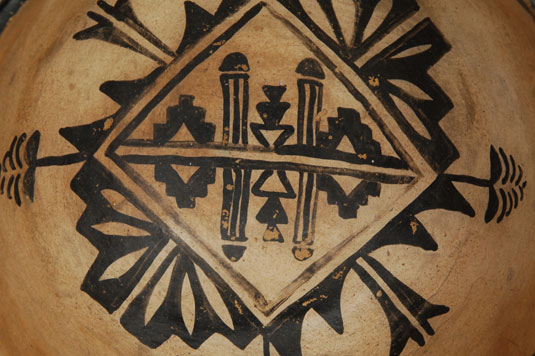Late 19th-century Cochiti Serving Bowl [SOLD]
+ Add to my watchlist Forward to Friend
- Category: Historic
- Origin: Cochiti Pueblo, KO-TYIT
- Medium: clay, pigment
- Size: 4” depth x 8” diameter
- Item # C3753.15 SOLD
Pueblo potters devised a method by which to start the construction of a new vessel that made use of a previous vessel. The bottom of a broken olla or an old bowl was used to form the beginning of a new jar by placing the clay in the older vessel and molding it to conform to the shape of the older one. The old broken vessel or any other form for starting a new vessel is called a puki.
The weight of new rolls of clay gradually caused the jar to expand out over the edge, forming a ridge or bulge as it rose above the top of the old vessel. This bulge was generally overlooked in historic pottery until around the turn of the 19th to the 20th century. It was then that potters sanded the outer wall of the vessel to eliminate the “puki line” or bulge. It is the existence of such a puki line that helps provide a time period when an item was made.
 This wonderful Cochiti bowl has a puki line just below the lower framing line. Additionally, it features a ¾-inch wide wiped-on red band, another clue to assist in establishing the age of a vessel. These two clues strongly suggest that this bowl dates to the late 1800s, perhaps 1890.
This wonderful Cochiti bowl has a puki line just below the lower framing line. Additionally, it features a ¾-inch wide wiped-on red band, another clue to assist in establishing the age of a vessel. These two clues strongly suggest that this bowl dates to the late 1800s, perhaps 1890.
The interior design is a typical Cochiti cluster of elements. The square in the center housed stacked triangles, stepped triangles, and linear bars with cloud caps. The black stepped attachments to the square center contain three feathers each. Francis Harlow once told me that those three feathers were a Cochiti identifying mark. Other design elements appear to be plants.
There is a band of black clouds on the inside of the rim and black-outlined clouds on the outer rim. The exterior design elements are feathers and rain. The entire design is interrupted with a ceremonial line break. The underside of the bowl is stone-polished natural body clay.
Condition: excellent condition with only a minimum of paint abrasion.
Recommended Reading: A River Apart – The Pottery of Cochiti & Santo Domingo Pueblos, edited by Valerie K. Verzuh
Provenance: from the extensive collection of a Santa Fe resident who unfortunately moved to another city and found it necessary to greatly reduce her collection.

- Category: Historic
- Origin: Cochiti Pueblo, KO-TYIT
- Medium: clay, pigment
- Size: 4” depth x 8” diameter
- Item # C3753.15 SOLD



